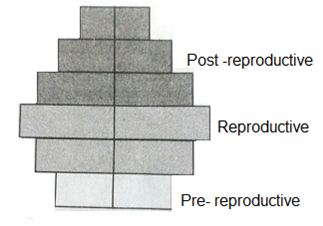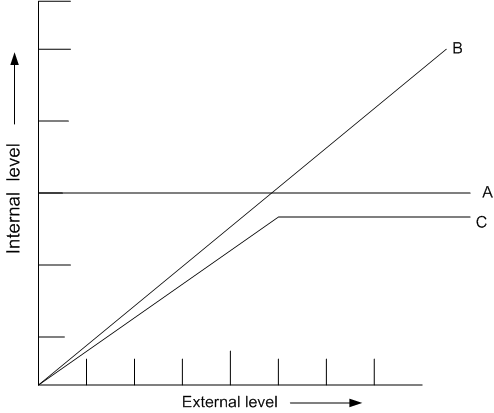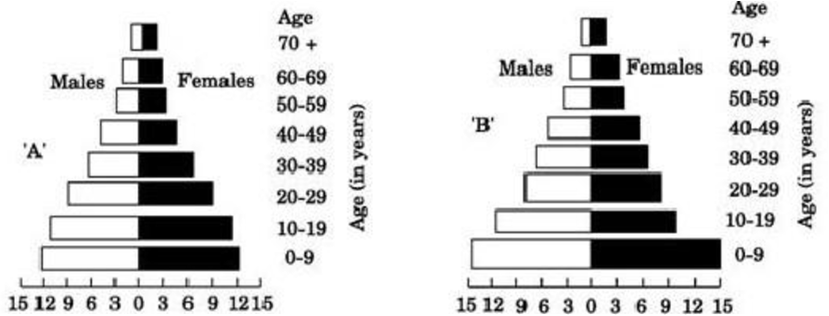 Multiple Choice Questions
Multiple Choice QuestionsWhich one of the following is categorised as a parasite in the true sense?
Human foetus developing inside the uterus draws nourishment from the mother
Head louse living on the human scalp as well as laying eggs on human hair
The cuckoo (koel) lays its eggs in crow's nest
The cuckoo (koel) lays its eggs in crow's nest
What type of human population is represented by the following age pyramid? 
Stable population
Declining Population
Expanding population
Expanding population
Consider the following statements (I) - (IV) each with one or two blanks.
I. Bears go into ..... (1) .... during winter to .......(2) ..... cold weather.
II. A conical age pyramid with a broad base represents ......(3) ....... human population.
III. A wasp pollinating a fig flower is an example of ........ (4) ..........
IV. An area with high levels of species richness is known as ........ (5) .......
Which one of the following options give the correct fill up the respective blanks numbers from (1) to (5) in the statements.
(2) stable, (4) commensalism, (5) marsh
(1) aestivation, (5) escape, (3) stable, (4) mutualism
(3) expanding, (4) commensalism, (5) biodiversity park
(3) expanding, (4) commensalism, (5) biodiversity park
The figure given below is a diagrammatic representation of the response of organisms to abiotic factors. What do A, B, and C represent respectively?
|
A
|
B
|
C
|
|
Conformer |
Regulator |
Partial regulator |
|
A |
B |
C |
|
Regulator |
Partial regulator |
Conformer |
|
A
|
B
|
C
|
|
Partial regulator |
regulator | conformer |
|
A
|
B
|
C
|
|
Partial regulator |
regulator | conformer |
Some hyperthermophilic organisms that grow in highly acidic (pH2) habitats belongs to the two groups called
eubacteria and archaea
cyanobacteria and diatoms
protists and mosses
protists and mosses
Which one of the following statemtents about morula in human is correct?
It has almost equal quantity of cytoplasm as an uncleaved zygote but much more DNA
It has far less cytoplasm as well as less DNA than in an uncleaved zygote
It has more or less equal quantity of cytoplasm and DNA as in uncleaved zygote
It has more or less equal quantity of cytoplasm and DNA as in uncleaved zygote
Which one of the following is most appropriately defined?
Host is an organism, which provides food to another organism
Amensalism is a relationship in which one species is benefited whereas the other is unaffected
Predator is an organism that catches and kills other organism for food
Predator is an organism that catches and kills other organism for food
A country with a high rate of population growth took measures to reduce it. The figure below shows age-sex pyramids of populations. A and B twenty years apart. Select the correct interpretation about them
Interpretations
'A' is more recent and shows slight reduction in the growth rate
'B' is earlier pyramid and shows stabilised
'B' is more recent showing that population is very young
'B' is more recent showing that population is very young
The table below gives the populations (in thousand) of ten species (A-J) in four areas (a-d) consisting of the number of habitats given within brackets aginst each. study the table and answer the question which follows:
|
Area and number of habitats
|
Species and their populations (in thousands) in the area |
|||||||||
|
A |
B |
C |
D |
E |
F |
G |
H |
I |
J |
|
|
a(11) b(11) c(13) d(12) |
23 |
1.2 |
0.52 |
6.0 |
- |
3.1 |
1.1 |
9.0 |
- |
10.3 |
|
10.2 |
- |
0.62 |
- |
1.5 |
3.0 |
- |
8.2 |
1.1 |
11.2 |
|
|
11.3 |
0.9 |
0.48 |
2.4 |
1.4 |
4.2 |
0.8 |
8.4 |
2.2 |
4.1 |
|
|
3.2 |
10.2 |
11.1 |
4.8 |
0.4 |
3.3 |
0.8 |
7.3 |
11.3 |
2.1 |
|
Which area out of a to d shows maximum species diversity?
b
c
d
d
